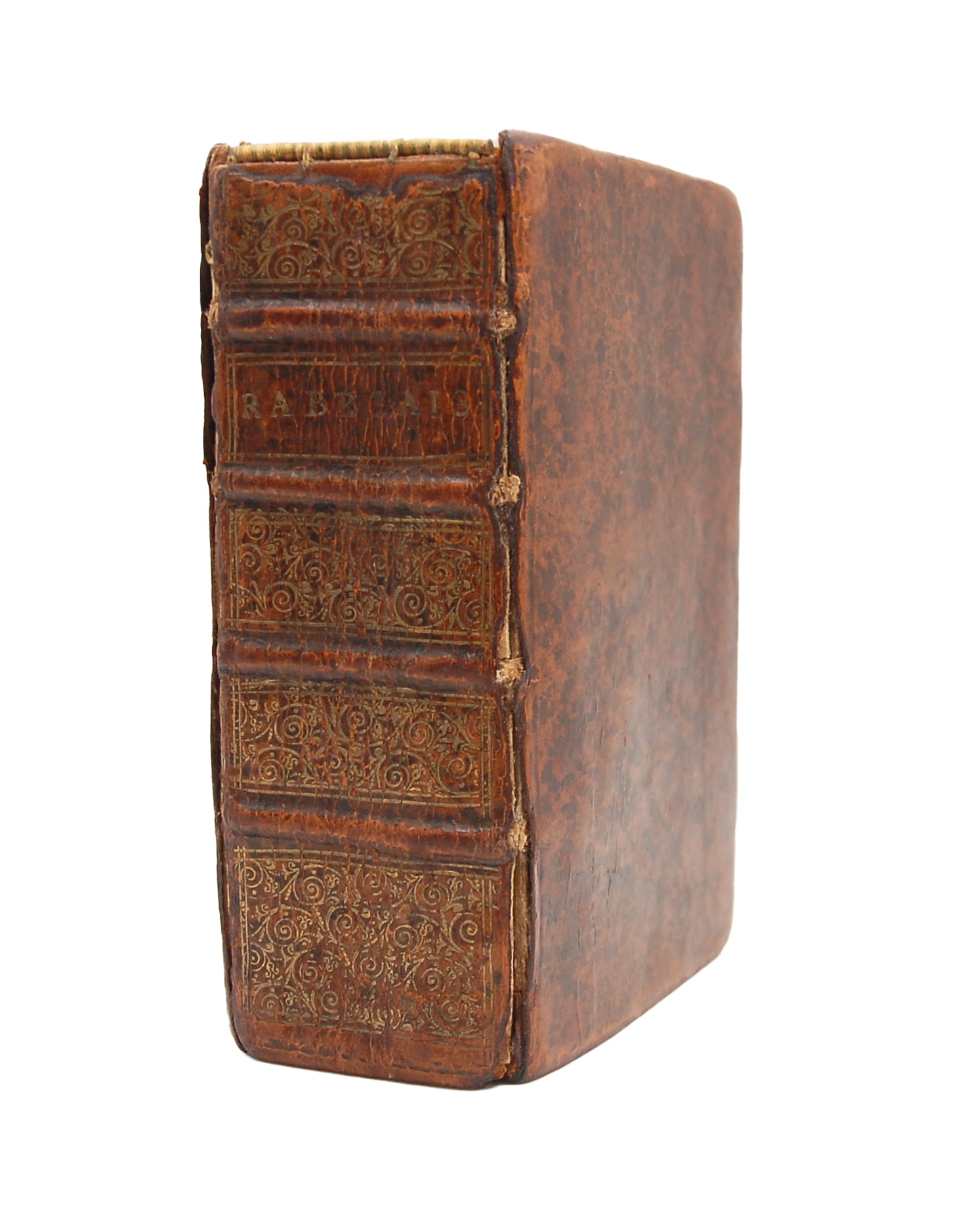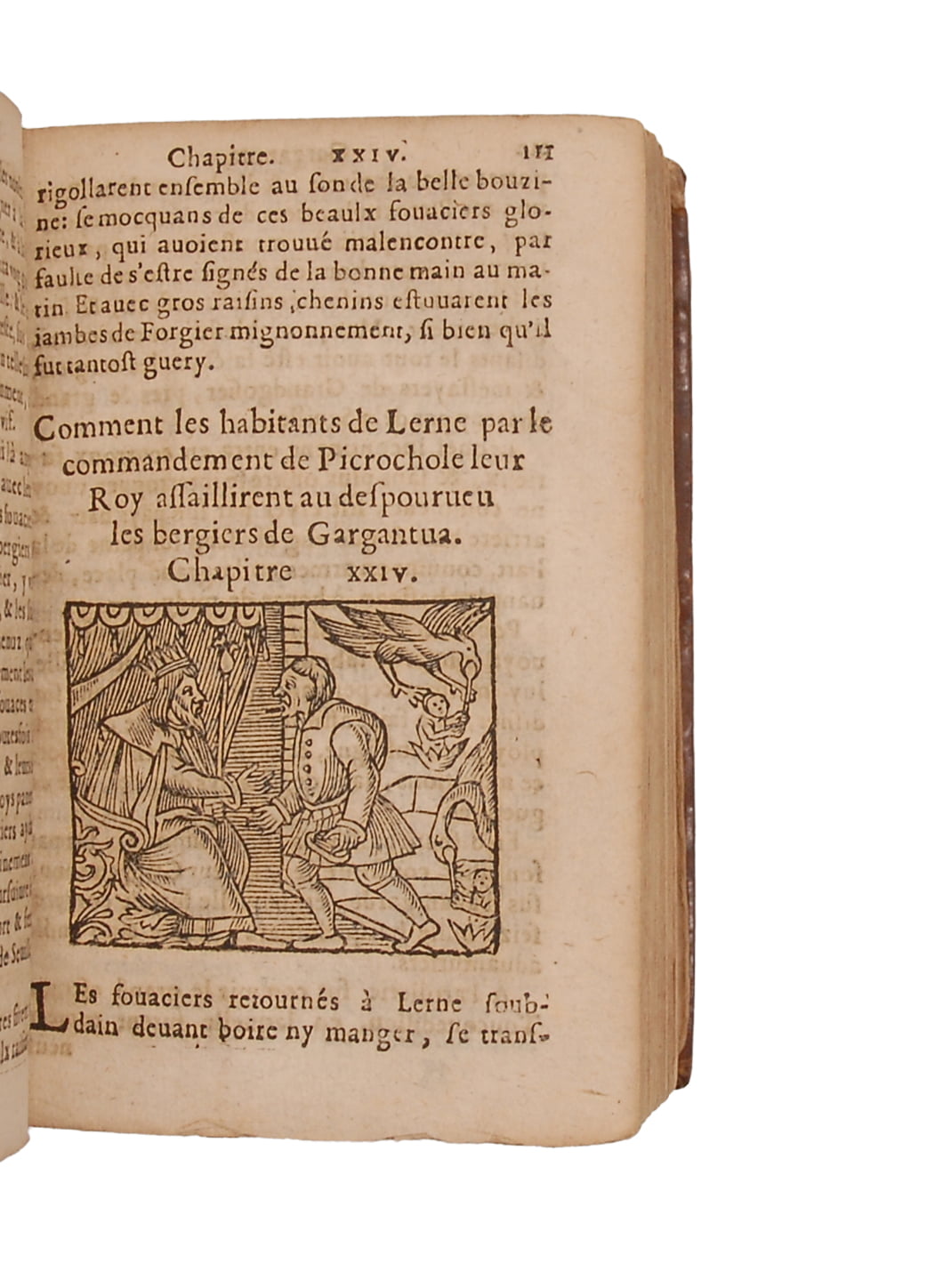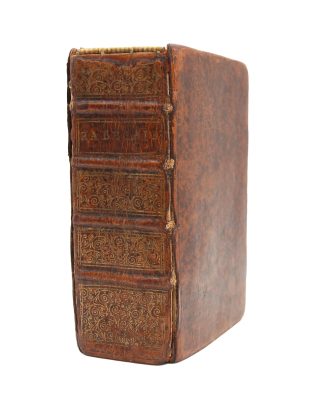RABELAIS, Francois
La Plaisante et Ioyeuse histoyre du grand Geant Gargantua. .. Second livre de Pantagruel, Roy des Dipsodes. Plus les merveilleuses navigations du disciple de Pantagruel, dict Panurge.
Valence [Geneva], chez Claude La Ville, 1547 [ie. 1600]£7,500.00
16mo. Three vols. in one. pp. 245 [xi]; 320; 349 [iii]. A-Q8 (Q4-8 blank); A-V8;A-Y8 (Y8 blank). Roman letter, charming ‘grotesque’ woodcut of singers on t-p (repeated in text), separate dated title to second and third parts, 58 small text woodcuts in first vol, 50 in the second and 59 in the third, three small woodcut initials, early bibliographical note on pastedown, mss. autographs crossed out on fly and pastedown. Light age yellowing, some minor browning, small tear to lower outer corner of t-p just touching a few letters of text on verso, some edges softening. A good copy in seventeenth century speckled calf, spine with raised bands single gilt ruled in compartments, filled with repeated gilt scrolls, head of spine and joints worn, a.e.r.
A beautifully illustrated counterfeit edition of the major works of Rabelais, copying the celebrated Valence edition of 1547. The illustration is composed of a series of 167 vignettes in the Lyon-style, a very charming form of popular imagery, many of which appear to have been copied from the first edition. The quality of the printing is clearer than in the original; Brunet “Dans cette contrefaçon, les figures sont un peu plus nettes que dans l’original”. Many early edns. of the various parts of Rabelais’ works do not state the printer or place of publication, or in a few cases give false information, owing to the ribald and in places anti-clerical subject-matter, which exposed his works to censorship: they had, for example, been on the papal Index since at least 1559. Due to the nature of their clandestine printing they were often cheaply and hastily printed and they were popular works, usually well read, so good copies such as this one are particularly rare. The editors here went to a good deal more trouble than in other counterfeit editions of the period, such as those printed by Fuet or Martin, with its very charming suite of illustration. “Rabelais was, for generations, read only in distorting editions which generated jokes of their own. All his Greek was turned into gibberish; careless arrangement of material by printers led Sterne to believe that Rabelais was sporting typographically with his reader by displacing a poem or by leaving blanks – hence the blanked-out chapter in Tristram Shandy. These editions – sometimes printed clandestinely in France – kept Rabelais alive but helped to create a ‘Rabelais legend’ which had nothing to do with the works he wrote. Montaigne enjoyed Rabelais, finding him at least ‘simplement plaisant’ (‘straightforwardly delightful’). Molière assumed that his audience enjoyed him too. And they did. For many Frenchmen Rabelais embodies that Gaulois humour which they love to see as a permanent element in the national character.” M. A. Screech. London Review of Books. Vol. 6 No. 17 · 20 September 1984. pages 11-13
“With an immense erudition, representing almost the whole knowledge of his time, with an untiring faculty of invention, with the judgement of a philosopher and the common sense of a man of the world, with an observation which let no characteristic of the time pass unobserved and with a ten-fold portion of the special Gallic gift of good-humoured satire, Rabelais united a height of speculation and depth of insight and vein of poetical imagination rarely found in any writer… his work is the mirror of the C16th. in France, reflecting at once its comeliness and its uncomeliness, its high aspirations, its voluptuous tastes, its political and religious dimensions, its keen criticism, its eager appetite and hasty digestions of learning, its gleans of poetry and its ferocity of manners”. Enc. Brit. 13th. ed.
BM STC fr. C16th. Rawles and Screech 39. Brun, p. 280. Plan 85. Brunet, IV, 1051-1052. Tchemerzine, V, p. 297In stock







